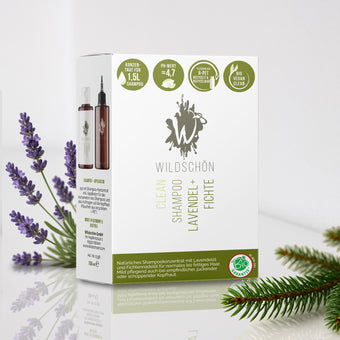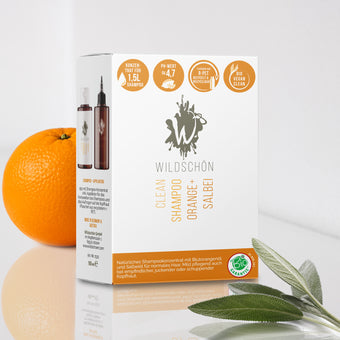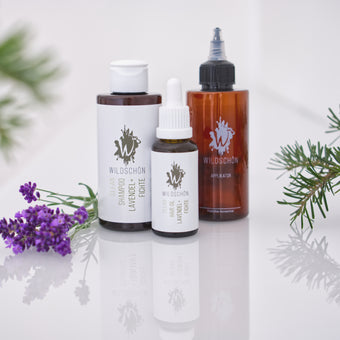Sour makes fun? Why shampoo pH is important
- What is pH actually?
- What pH is good for skin (and why)?
- Why do hair soaps need an acidic rinse? And why can it be too acidic?
After we have already dealt extensively with the various ingredients of shampoos and their effects, another topic comes up today: the pH value. If you have a slight frown on your forehead at the thought of chemistry class - don't worry! This article will not be a tutoring lesson, but a practical use case. That's usually more interesting. Perhaps the memory of a color scale creeps in at this point - you are spot on! But what was pH again, exactly? And what does that have to do with shampoos? In this article, we'll look at the basics of pH again together and explain why it's important, even though it's usually not found on shampoo bottles. On the test strips, get set, go!
What is the pH actually?
pH is often described as a measure of how acidic or alkaline an aqueous solution is. So far so good. The abbreviation pH stands for pondus hydrogenii or potentia hydrogenii (for all non-Latin speakers: pondus = weight, potentia = power and hydrogenium = hydrogen). So it's about the force or weight of the hydrogen in a liquid. Strictly speaking, the pH value is a number and is calculated. It states how many hydronium ions are dissolved in a liquid. This hydronium ion concentration is then used to classify liquids as acidic, neutral or alkaline on the pH scale.
What do the numbers on the pH scale say?
Since pH is a number, the scale is theoretically open-ended. In practice, a pH value scale from 0 to 14 or 1 to 14 is usually used, since there are hardly any applications for the other values. Anything below 7 is considered acidic, and anything above 7 is considered alkaline. And when the pH is exactly 7, that's called "neutral." Pure water is usually given as an example of a neutral pH of 7.0. However, the water from the tap has a pH value between 6.0 and 8.5, depending on the degree of hardness. Graphically, the whole thing looks like this, for example, and it may look familiar to you:

What pH is good?
A value doesn't say much at first if you don't know what it means. For example, if you bite into a lemon, you taste a pH of around 2. Is this a good value? Well, for lemons, he seems right! Neutral somehow sounds good, sour rather not. And alkaline after batteries. The question of what pH level is good depends on what you're looking at: In your stomach, a level between 1.2 and 3 is a good level. As a result, your stomach acid breaks down your food well and kills microorganisms. With the secretion of your pancreas, on the other hand, a pH value of around 8 is good - otherwise your acidic stomach contents would corrode your intestines quite a bit. And your blood pH is in a good range between 7.3 and 7.4.
What pH is good for the skin?
But what about shampoos? Which pH value is good there? To do this, we have to look at the pH value of human skin. Even if the skin is not liquid, you can measure it. This is possible because the outermost layer of skin has a water content of around 25 to 30 percent. Therefore, their pH can be measured using certain measurement methods. Back to the topic. The pH of the skin's surface is around 5.5, which is slightly acidic. It's the same with the scalp. Surprised? Well, there is a good reason for this low value: This pH range is not one in which bacteria can multiply well. The slightly acidic surface of the skin is therefore a kind of protective shield (you may have heard the term "skin's acid mantle"). The pH of human hair fibers is even lower at around 3.7. Well, and what does that mean for the pH value of shampoos?
What pH should a shampoo have?
There is no exact answer in terms of the correct pH value for a shampoo. Because just as tap water varies, the pH value of the skin can also vary slightly from person to person. However, one thing is clear: the pH of a shampoo should be in the pH range of the scalp. If the pH of a shampoo differs too much from that of your scalp, this can have negative effects in the long run. Because every time you wash them with an alkaline or too acidic shampoo, this changes their natural protective acid mantle. It takes a few hours for the skin to restore its natural pH level. Skin irritation, a dry scalp or brittle hair can be the result of an unfavorable pH value in shampoos. Now you might want to know how to find out the pH level of a shampoo.
How do I find out the pH of shampoo?
Unfortunately, looking through the magnifying glass at the small print on the shampoo bottle does not help here, as with the ingredients. The pH value is usually not explicitly specified for cosmetic products. In most cases, it is only given if a shampoo has the usual pH value of the skin (i.e. around 5.5). If you want to know the pH of a shampoo, you could ask the manufacturer or measure it yourself using pH test strips. You don't need to bother with Wildschön shampoos - we'll tell you that! The pH values of our shampoo concentrates are 4.67 for lavender-spruce, 4.65 for orange-sage and 4.66 for rosemary-bayrum. So they are all in the slightly acidic range.
Does the pH of concentrates change when mixed?
Now you might be thinking: wait a minute, I'll dilute that with water! What about the pH value afterwards – does it change? This question is absolutely valid and the answer is yes. However, not to an excessive extent. If you fill the concentrate up to the mark and then fill up the applicator bottle with water, you have diluted the concentrate 10 times (+/- a few milliliters - depending on how full you fill the bottle). In purely mathematical terms, this would increase the pH value by one level. However, since tap water has a slightly different pH value depending on the degree of hardness, the pH value for ready-mixed Wildschön shampoo cannot be given in general. That would then be a case for the test strip. However, we have designed our shampoos in such a way that you achieve an optimal value on average after mixing. You are welcome to experiment with a slightly different mixing ratio.

What is the pH of conventional shampoos?
If you are now wondering how the pH value in conventional shampoos is in general, we can still help you a little. Scientists have dealt with this question in a study. They wanted to clarify whether it's a myth that shampoo pH can affect hair. To do this, they tested the pH of 123 brands of shampoo, including well-known drugstore and supermarket brands as well as salon brands. The result: Only 38 percent of well-known branded shampoos had a pH value of 5 or less. For salon shampoos, on the other hand, it was 75 percent. One wonders why there are such differences here. A look at the effects of alkaline shampoos helps to answer this question.
Many conventional shampoos are alkaline
Alkaline shampoos open the outer cuticle layer of the hair. As a result, they clean the hair more (are you also thinking about commercials that promise you thoroughly cleaned hair?). Since hair with protruding outer scales tends to look frizzy and lackluster, a conditioner is recommended in this case. Alternatively, you can also find a tip on the internet to use an acidic rinse. A sour rinse is nothing more than water mixed with a little lemon juice or apple cider vinegar. The hair is then rinsed with it, preferably without the acidic rinse getting on the scalp. This mixture is logically relatively acidic and this causes the hair scales to attach again - acid has an astringent (i.e. contracting) effect. Hair becomes smoother and smooth hair surfaces shine more because they reflect light better. But watch out! A lot helps a lot isn't the way to go when mixing acidic rinses. Because if you put too much of whatever acid in the water, then the acidic rinse can easily become too acidic. In addition, the pH of the acidic rinse also depends on the pH of your tap water. So, to avoid a too-acidic rinse, you would need to test the tap water, the acid to be added, and ultimately the finished mix. Because if a rinse that is too acidic comes into contact with your scalp, it can also become uncomfortable. Depending on the pH value of your shampoo, it may not be right.
Hair soaps also have a high pH value
An acidic rinse is also recommended for the currently trendy hair soaps - especially if the water is very hard. This is because hair soaps - like other soaps - have an alkaline pH. It is usually between 8.5 and 9.5. So that the hair does not dry out because the alkaline hair soap opens the outer layer of hair cuticles, there is the so-called excess fat content. In the case of hair soaps, this means that some of the oils used simply remain as oils in the hair soap and are not made into soap. This oil content is referred to as overfatting. If the percentage of excess fat is higher, then the hair is logically more fatted. Depending on how dry your hair is, the excess fat content is also a value that you should look at.
Conclusion: Pay attention to the skin-friendly pH value
Basically, the pH value of a shampoo is just as important as its ingredients. Unfortunately, it is usually not recognizable by looking at the shampoo bottle. Many hair shampoos are alkaline and are therefore far removed from the natural pH of the scalp. Therefore, you also need a conditioner or an acidic rinse so that the hair is not frizzy and dull after washing. With our Wildschön shampoo concentrates, we have not only thought about the clean ingredients, but also about the pH value. Even after dilution, it is still in a skin-friendly range. That's why you don't need an acidic rinse or conditioner with our shampoos. Because if you use our shampoos for a while, they help your hair and scalp to regulate themselves. This is made possible on the one hand by our ingredients and on the other hand by daily brushing, with which the natural hair sebum (the sebum) is distributed. This is how you get naturally beautiful hair.









